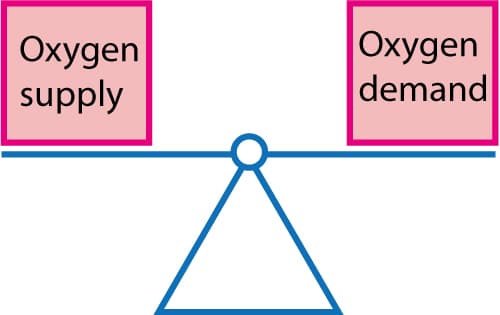Myocardial ischemia
The definition of ischemia may appear trivial but it is actually a very complicated topic. The term ischemia was coined in 1858 by Virchow (the same Virchow who unraveled thrombosis). He used te term to describe a reduction of blood flow to tissues and organs. A few decades later Cohnheim demonstrated that ligation of the left anterior descending artery in dogs resulted in myoardial infarction. An important discovery was reported in 1930 when Buchner and colleages showed that myocardial contractility was closely related to myocardial blood flow. This concept is of outmost importance, as it suggests that myocardial contractility and blood flow are closely matched. Indeed, studies demonstrate that the relation between contractility and blood flow is virtually linear (there are rather few linaer associations in physiology). Refer to Figure 1.

The relationship illustrated in Figure 1 has been confirmed in numerous studies [1]. Perhaps the most important implication of the theory is that
However, the vast majority of cardiology textbooks still teach that ischemia is the result of a mismatch (imbalance) between oxygen supply and oxygen demand, as illustrated in Figure 2. This theory suggests that ischemia occurs as soon as oxygen supply exceeds oxygen demands.

In spite of its spread in textbooks, this theory has not been proven, mostly because we have never been able to measure oxygen demand (measuring oxygen supply is easy). Thus, the theory regarding supply/demand balance has always been conceptual and lacks scientific evidence. As suggested by Heusch, [1] this may be due to the fact that interventions that appear to modify oxygen demand also modify infarct size. The most notable interventions are cathcholamines and beta-blockers. Catecholamines incrases oxygen consumption and thus infarct size. Beta-blockers may limit or even reduce infarct size, which is generally attributed to its reduction of heart rate and contractility. But as it turns out, [2] the reduction in heart rate and contractility appears to act through a redistribution of blood from non-ischemic to ischemic myocardium (i.e an increase in blood flow in the ischemic area!) [2].
Take home message: in the setting of acute coronary syndromes, be quick to administer antithrombotic medications and reperfusion.
Refer to G Heusch’s excellent review on this topic [1].
References
[1] G Heusch. Myocardial Ischemia: Lack of Coronary Blood Flow or Myocardial Oxygen Supply/Demand Imbalance? Circ Res. 2016;119:194-196.
[2] Guth BD, Heusch G, Seitelberger R, Ross J Jr. Mechanism of beneficial ef- fect of beta-adrenergic blockade on exercise-induced myocardial ischemia in conscious dogs. Circ Res. 1987;60:738–746. doi: 10.1161/01.RES.60.5.738.
